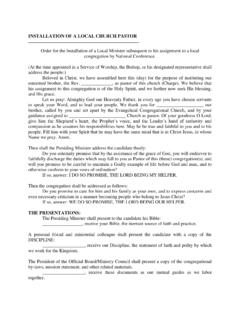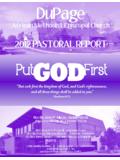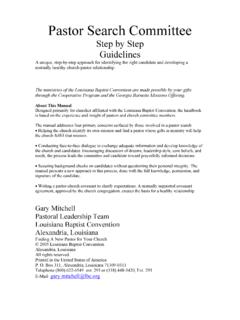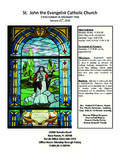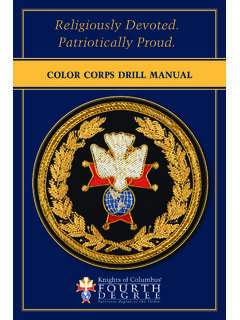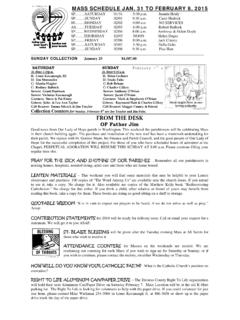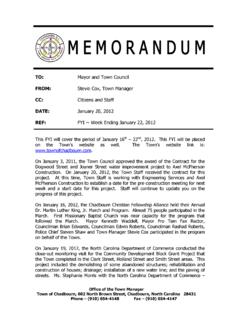Transcription of Discipline of EMC 2010 - emchurch.org
1 Discipline . OF THE. EVANGELICAL. METHODIST church . 2010 Edition Evangelical Methodist church International Headquarters Indianapolis, Indiana Published by the authority of the 30th General Conference of the Evangelical Methodist church , held in Indianapolis, Indiana March 12-15, 2010. Printing 2010. 2010 by the General Conference of the Evangelical Methodist church 2|P a g e Table of Contents All references are to paragraphs HISTORICAL STATEMENT. Paragraphs 1-18. CONSTITUTION. Paragraphs 21-199. Chapter 1. Articles of Religion .. 21- 46. Chapter 2. General Rules .. 51- 54. Chapter 3.
2 church Government .. 61- 64. Chapter 4. Basic Denominational Principles .. 71-103. Division 1. Outlook .. 71- 75. Division 2. Conferences .. 81- 84. Division 3. Ministry .. 91- 92. Division 4. Administration .. 101-103. Chapter 5. Amendments to the Constitution .. 111-112. Chapter 6. By-Laws .. 121-122. BY-LAWS. THE LOCAL church . Paragraphs 201-399. Chapter 1. Purpose .. 201-213. Chapter 2. Membership .. 221-227. Chapter 3. Annual church Conference .. 231-244. Chapter 4. Special church Conference on Pastoral Relations .. 251-260. Chapter 5. Annual Committees .. 271-289. Chapter 6.
3 Board of Trustees .. 301-305. Chapter 7. Board of Stewards .. 321-330. Chapter 8. Elected Officers .. 341-346. Chapter 9. Sunday School .. 361-367. Chapter 10. church Council .. 381-383. THE DISTRICT CONFERENCE. Paragraphs 401-499. Chapter 1. Composition .. 401-404. Chapter 2. Business .. 411-415. Chapter 3. Regions .. 421-430. THE MISSION CONFERENCE. Paragraphs 501-599. Chapter 1. Composition .. 501-502. Chapter 2. Election . 511. Chapter 3. Rules and Powers .. 521-528. THE GENERAL CONFERENCE. Paragraphs 601-699. Chapter 1. Composition .. 601-613. Chapter 2. Elections .. 621-628.
4 Chapter 3. Rules and Powers .. 631-643. 3|P a g e CONFLICT RESOLUTION. Paragraphs 701-799. THE MINISTRY. Paragraphs 801-999. Chapter 1. The Call to Preach .. 801-807. Chapter 2. The Matter and Manner of Preaching .. 811. Chapter 3. The Preacher in Charge .. 821-824. Chapter 4. The Conference Superintendent .. 841-843. Chapter 5. The General Superintendent .. 851-853. Chapter 6. Ministerial Relations .. 871-890. Chapter 7. Termination of Ministerial Relationship .. 901-912. Chapter 8. Course of Study for Preachers .. 921-924. JUDICIAL ADMINISTRATION. Paragraphs 1001-1099. Chapter 1.
5 Offenses .. 1001-1002. Chapter 2. Investigation and Trial of Ministers .. 1011-1025. Chapter 3. Investigation and Trial of Lay Members .. 1031-1036. Chapter 4. General Directions .. 1041-1049. Chapter 5. Appeals .. 1061-1066. RITUAL AND WORSHIP. Paragraphs 1101-1499. Chapter 1. Order of Worship .. 1101-1104. Chapter 2. Calls to Worship .. 1111. Chapter 3. Calls to Evening Worship .. 1121. Chapter 4. Invocations .. 1131. Chapter 5. Affirmations of Faith .. 1141-1142. Chapter 6. The Lord's Supper or Holy Communion .. 1151. Chapter 7. Dedication and/or Baptism of Children and Infants.
6 1161. Chapter 8. Baptism .. 1171. Chapter 9. Receiving Persons into the church .. 1181. Chapter 10. Receiving Persons by Transfer .. 1191. Chapter 11. Wedding Ceremonies .. 1201-1202. Chapter 12. Burial of the Dead .. 1301. Chapter 13. Burial of a Child .. 1311. Chapter 14. Ordination of Elders .. 1321. Chapter 15. Dedication of a General Superintendent .. 1331. Chapter 16. Commissioning of Missionaries .. 1341. Chapter 17. Consecration of Diaconal Ministries Deacons and 1351. Chapter 18. Installation of New Pastor .. 1361. Chapter 19. Installation of church Officers and Committees.
7 1371-1372. Chapter 20. Installation of Sunday School and VBS Teachers and Workers .. 1381-1382. Chapter 21. Groundbreaking .. 1391. Chapter 22. Laying the Cornerstone of a church .. 1401. Chapter 23. Dedication of a church .. 1411. INDEX. 4|P a g e HISTORICAL STATEMENT. 5|P a g e HISTORICAL STATEMENT. 1. The doctrine and spirit of pure Bible Christianity have existed at different times and in different degrees in all branches of the church of Christ. 2. In 1729 two young men in England, reading the Bible, saw that they could not be saved without holiness, followed after it, and incited others so to do.
8 In 1737 they saw likewise that men are justified before they are sanctified; but still holiness was their object. God then thrust them out to raise up a holy people.. 3. This was the rise of Methodism as described in the words of its founders, John and Charles Wesley. The name Methodist was applied to a group of students led by the Wesleys and George Whitefield in the University of Oxford, England, who came together for intellectual and spiritual improvement. Their systematic way of living merited the name, which was given them by fellow students. 4. On the evening of May 24, 1738, John Wesley had undergone his heart-warming experience at a meeting of a religious society on Aldersgate Street, in London; an experience which his brother, Charles, had previously found.
9 About a quarter of nine, while listening to Luther's description of the change, which God works in the heart through faith in Christ, he says: I felt my heart strangely warmed. I felt I did trust in Christ alone for salvation; an assurance was given me that He had taken away my sins, even mine, and saved me from the law of sin and death.. 5. The original associations formed by Mr. Wesley and his preachers were called societies. They were voluntary associations of persons for mutual improvement in experimental and vital piety. They were still members of the church of England; they attended its regular services and received the sacraments at its altars.
10 A great revival began to spread over the British realm. It was a work of great depth and duration. To the Methodists God committed the precious work of awakening the British Kingdom to a sense of God and duty, and by them He wrought a reformation which stands alone as a spiritual revival without admixture of statecraft or patronage, or parliament or king. 6. The first Methodist Society was organized in 1739 when eight or ten persons, who appeared to be deeply convinced of sin and earnestly groaning for redemption, came to John Wesley. They desired, as did two or three more the next day, that he would spend some time with them in prayer and advise them how to flee from the wrath to come.
